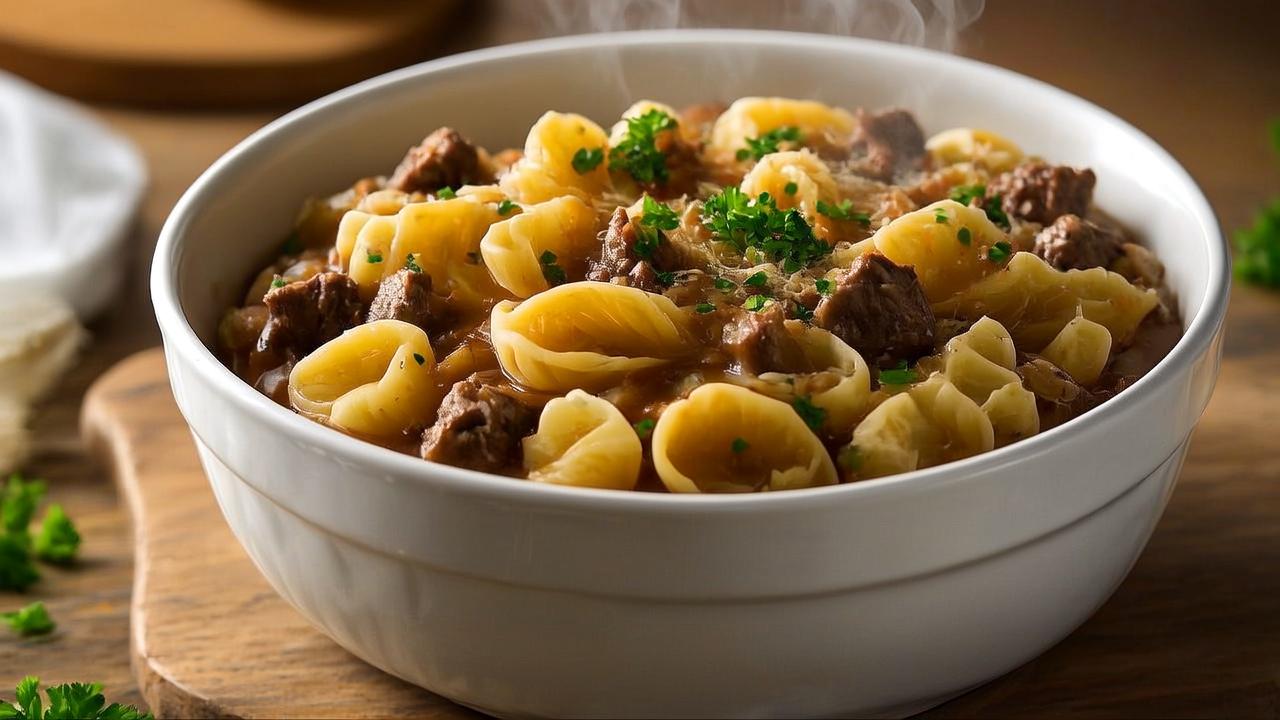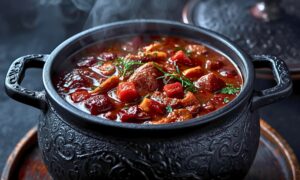Ultimate One Pot French Onion Pasta isn’t just a recipe, it’s a revelation. What if I told you that the most soul stirring comfort food was hiding in your pantry all along, disguised as basic ingredients you probably walked past a dozen times this week?
That’s exactly what happened when I discovered One Pot French Onion Pasta during a particularly uninspiring Tuesday evening. I was craving that deep, caramelized magic of French onion soup but wanted something that could actually fill me up without requiring a loaf of bread as backup. This dish shattered every rule about keeping cuisines in their lanes, and honestly? I’m absolutely here for it.
One Pot French Onion Pasta captures all that rich bistro magic, those perfectly caramelized onions, that soul warming broth, that blanket of melted cheese, and transforms it into something even more satisfying. We’re talking pasta that actually absorbs those incredible flavors instead of just sitting underneath them like some sad afterthought.
Here’s what makes this recipe pure genius. One pot means cleanup takes five minutes. The pasta cooks directly in flavored liquid, soaking up every drop of goodness. Everything comes together faster than traditional soup. You’ll learn fundamental techniques that transform how you approach weeknight cooking forever.
The Art of Perfect Caramelized Onions
Let’s talk about our star player first. These onions aren’t just sliced and tossed in carelessly.
We’re coaxing out their natural sugars through proper caramelization. This process transforms sharp, pungent onions into something sweet and complex. Most people rush this step because twenty minutes feels eternal when you’re starving.
But here’s the truth, shortcuts lead to disappointment every single time. The good news? Once you understand what’s happening, time flies, and your kitchen starts smelling like pure comfort.
Yellow onions give us perfect balance between sulfur compounds and sugars. White onions stay too sharp, red onions get too sweet. Cut them into half moons for maximum surface area while keeping structural integrity.
The secret most home cooks miss? Salt right at the beginning draws out moisture, actually speeding caramelization. Watch them transform from raw to golden to deep amber. Those beautiful brown bits are pure concentrated flavor, and they’re the backbone of everything that follows in this dish.
Essential Ingredients for One Pot French Onion Pasta Success
Here’s your shopping list, organized exactly how you’ll use everything:
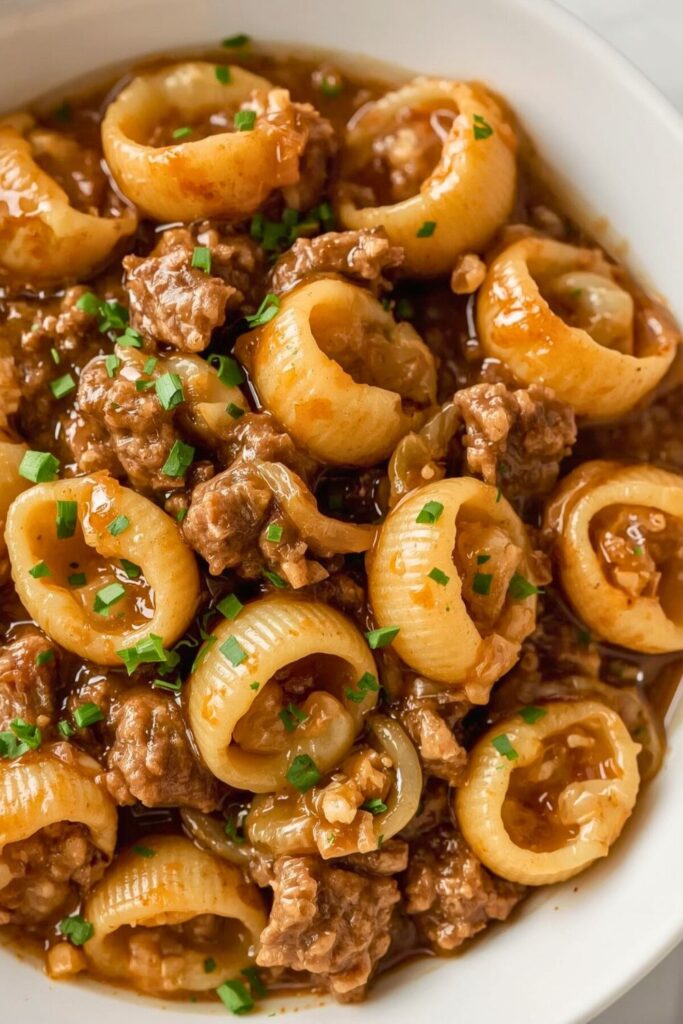
Building the Base:
- 3 large yellow onions, sliced into half moons
- 3 tablespoons butter (margarine ruins everything)
- 1 tablespoon olive oil
- 1 teaspoon salt
- 1/2 teaspoon sugar (secret weapon activated)
Creating the Body:
- 3 cloves garlic, minced fine
- 1/2 cup dry white wine
- 4 cups beef broth (vegetable works, beef delivers)
- 1 teaspoon fresh thyme leaves
- 1 bay leaf
- 12 oz short pasta shapes
The Grand Finale:
- 1 cup Gruyère cheese, freshly grated
- 1/2 cup Parmesan, freshly grated
- Fresh black pepper
- Chopped chives for serving
Smart Swaps That Actually Work
Can’t find Gruyère? Aged Swiss delivers similar nutty notes perfectly. Budget friendly option? Mix equal parts mozzarella and Parmesan. The key is cheese that melts beautifully.
No white wine? Replace with extra broth plus white wine vinegar splash. Apple cider vinegar works too if that’s available.
Beef broth expensive? Use vegetable broth plus soy sauce tablespoon. I’ve made this variation countless times with stellar results.
Gluten free friends, rice pasta or chickpea pasta works beautifully here. Just watch cooking times – they turn mushy faster.
Mastering One Pot French Onion Pasta Technique
Step 1: Caramelize Like a Pro
Heat Dutch oven over medium heat. Add butter and oil together. This combo delivers butter flavor with oil’s higher smoke point.
Toss sliced onions with salt and sugar. Now practice patience. Stir occasionally but don’t hover anxiously. Let them work their magic naturally.
Five minutes brings translucent onions. Ten minutes shows golden edges. Fifteen to twenty minutes creates deep golden brown perfection. If browning too fast, lower heat. Nothing happening? Crank up slightly.
Step 2: Build Flavor Foundation
Add minced garlic, stir thirty seconds until fragrant. Pour wine, let it bubble while scraping browned bits. This deglazing captures incredible flavor hiding on pot bottom.
Add thyme and bay leaf, pour in broth. Bring to gentle boil, add pasta directly to liquid. This technique infuses pasta with flavor instead of plain water.
Step 3: Perfect Pasta Absorption
Stir pasta well for complete submersion. Reduce heat, maintain steady simmer. Cook per package directions, stirring every few minutes.
Check doneness two minutes early. We want just shy of al dente since residual heat finishes cooking with cheese.
Step 4: Cheese Integration Mastery
Remove from heat, fish out bay leaf. Add grated Gruyère and Parmesan, stirring gently until melted. Residual heat melts cheese without creating stringiness.
Taste, adjust seasoning with salt and pepper accordingly. Every batch needs different seasoning depending on ingredients used.
The Science Behind One Pot French Onion Pasta Magic
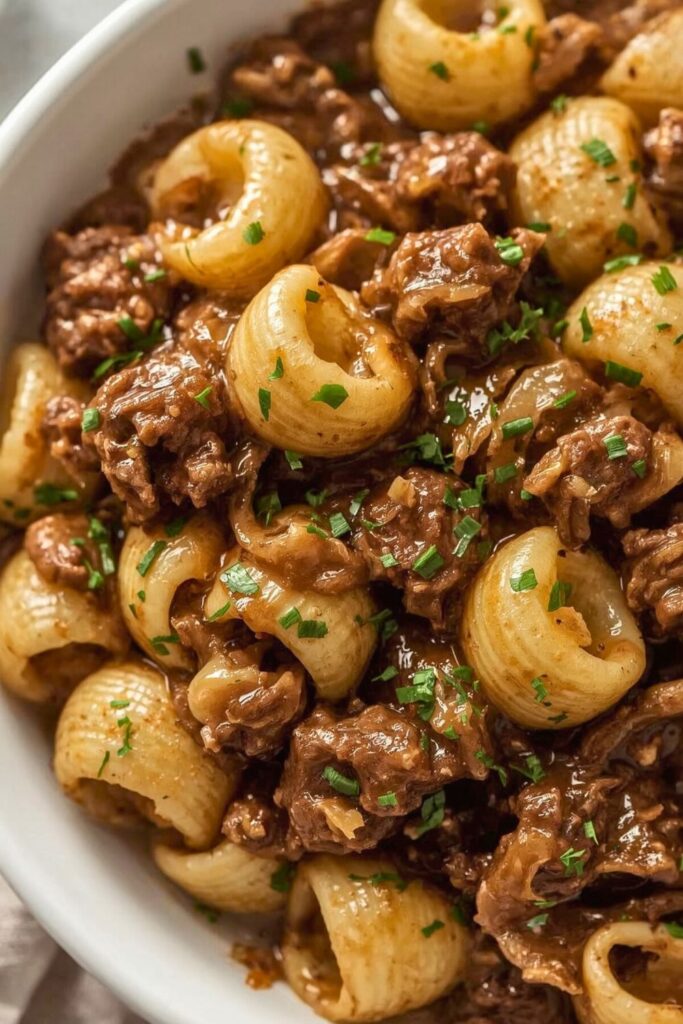
We’re essentially creating risotto style pasta using French onion soup flavors. Pasta releases starch directly into flavored liquid, naturally thickening everything.
Caramelization uses the Maillard reaction, same process that makes grilled meat incredible. Complex flavors develop as onions’ sugars break down slowly.
Adding wine after caramelization matters tremendously. Alcohol pulls flavor compounds that water alone can’t touch. Then it cooks off completely, leaving concentrated goodness.
Gruyère melts beautifully because of perfect moisture content and protein structure. It’s aged enough for complex flavors but young enough for smooth melting.
Presentation Tips for One Pot French Onion Pasta Perfection
Warm your bowls first, run under hot water, dry quickly. Hot pasta in warm bowls maintains perfect temperature longer.
Fresh chives add color and gentle onion bite without competing. Extra Parmesan shavings never hurt anyone either.
Pair with simple arugula salad dressed in lemon vinaigrette. Peppery greens cut through richness beautifully. Wine wise, try Côtes du Rhône or Pinot Noir.
Advanced One Pot French Onion Pasta Variations
Master the basics first, then experiment boldly. Stir in leftover rotisserie chicken for protein boost. Add baby spinach at the end for color.
Some folks love sliced mushrooms with the onions for earthiness. Others prefer caramelized shallots mixed with yellow onions for complexity.
This keeps beautifully as leftovers, though you’ll need extra broth when reheating. Pasta continues absorbing liquid while sitting. Warm gently, add liquid until reaching desired consistency.
Your New Weeknight Victory Meal
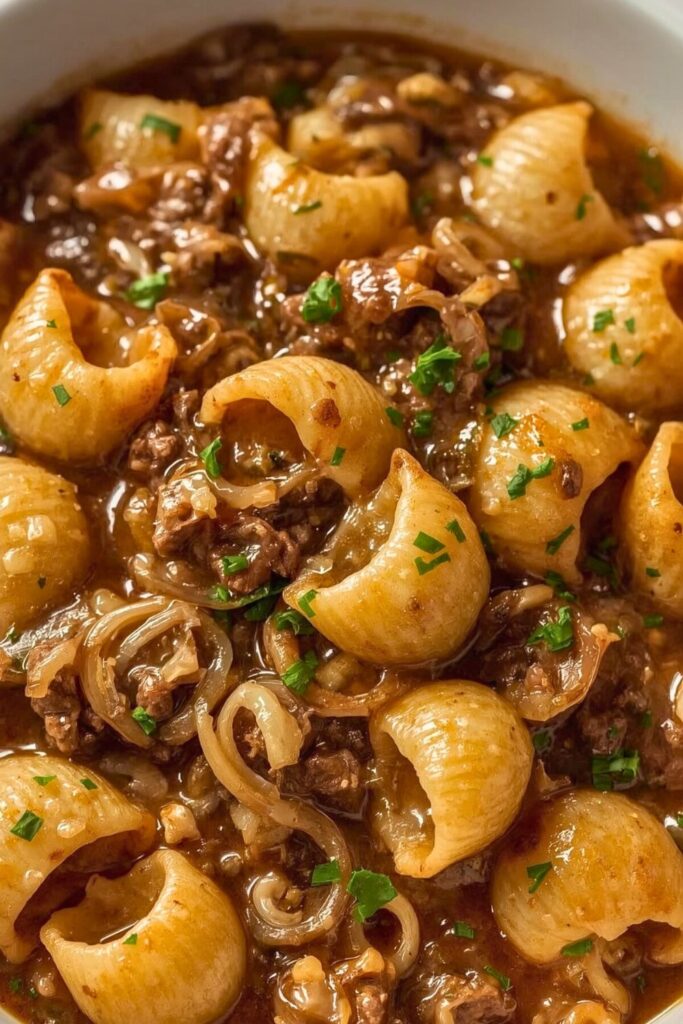
One Pot French Onion Pasta proves comfort food doesn’t require complexity or hours. You get French onion soup’s soul warming satisfaction with pasta’s heartiness. Everything cooks in one pot, no juggling pans, no overwhelming cleanup.
The best part? This recipe builds fundamental cooking skills naturally. You’re learning proper caramelization, flavor layering, and pasta cooking techniques you’ll use forever, without even realizing it. It’s a stealthy culinary education wrapped in cheese and onions.
Once mastered, this becomes your go to crowd pleaser. It’s sophisticated enough for company yet simple enough for Tuesday night. The kind of recipe that makes people ask for your secret, then look shocked when you say, “One pot, 30 minutes, and ingredients I already had.” It’s your new signature dish, effortless, elegant, and unforgettable.
Ultimate One Pot French Onion Pasta: Q&A
Can I prepare One Pot French Onion Pasta components ahead?
Yes, you can absolutely prepare parts in advance. The caramelized onions can be made up to three days ahead and stored in an airtight container in the refrigerator. Just ensure they’re completely cooled before sealing. When you’re ready to cook, simply start from the step where garlic is added. However, it’s best to cook the pasta fresh when assembling the dish, since pasta continues absorbing liquid even after cooking and can turn overly soft or mushy if stored.
What happens if my onions burn during caramelization?
Unfortunately, if your onions burn and develop black bits, the entire batch is ruined and you’ll need to start over. Burnt onions have a bitter, unpleasant taste that can overpower the dish. Always caramelize over medium or medium low heat, stirring frequently. If you notice them browning too fast, reduce the heat and add a tablespoon of water to slow the cooking process. Caramelization takes time, be patient, and your onions will reward you with rich, sweet flavor.
Which pasta shapes work best for One Pot French Onion Pasta?
For best results, stick to short, sturdy pasta shapes that can hold up in a one pot method and absorb the sauce well. Penne, rigatoni, shells, rotini, and even fusilli are excellent choices because their nooks and ridges capture flavor beautifully. Avoid delicate shapes like angel hair or vermicelli, as they tend to overcook quickly and become mushy. Heartier shapes allow the dish to stay rich and satisfying without compromising texture.
My pasta absorbed all liquid but isn’t cooked through yet?
Don’t worry, this is a common issue with thicker or denser pasta shapes. If the liquid has been absorbed but the pasta still feels undercooked, simply add more warm broth, about half a cup at a time. Stir and continue simmering until the pasta reaches your desired tenderness. The extra liquid will reduce as it cooks and actually deepen the flavor. This slow absorption process often enhances the dish’s creamy, luxurious texture without diluting the taste.
How do I recognize properly caramelized onions?
Properly caramelized onions should be a rich, deep golden brown in color and give off a naturally sweet, almost jammy aroma. They should look glossy and soft, with their volume reduced by more than half. You’ll notice some dark edges and a texture that’s tender but not mushy. The taste should be complex, sweet, earthy, and slightly savory, with no bitterness. If they smell sharp or sour, they’re either undercooked or slightly burned and not ready yet.

Swiftly Captions by Tina Smith — Quick, flavorful food recipes made simple, bringing fresh inspiration to your kitchen every day
